MENTAL DISORDERS IN CHILD EPILEPSY
Abstract
Introducere Epilepsia este o afectiune cronica caracterizata prin prezenta crizelor cerebrale paroxistice recurente (crize epileptice),ca urmare unei descarcari excesive a neuronilor . Prevalenta tulburarilor psihice in epilepsie este de 30- 40%,iar cea a psihozelor de 1-3%,fiind mai mare la pacientii cu epilepsie de lob temporal.Psihozele si tulburarile de personalitate sunt de 3 ori mai frecvente la cei cu crize de lob temporal.Dintre tulburarile psihice in epilepsia copilului amintim:deficitul cognitiv,tulburarile de comportament cu agresivitate si agitatie psiho- motorie,tulburarile de invatare,depresia,anxietatea. Material si metode Au fost evaluati 24 copii cu epilepsie, internati in 2014 in Clinica de Neurologie si Psihiatrie pediatrica Tg- Mures,avind virsta cuprinsa intre 12 si 18 ani.S-au aplicat matricea Raven,diferite scale pentru depresie si anxietate(MASC, Hamilton,Beck,Bender).Diagnosticul tulburarilor psihice s-a stabilit pe baza criteriilor DSM-V si ICD 10. Rezultate Prevalenta tulburarilor psihice in epilepsie a fost de 0,14%,cu incidenta cea mai mare la grupa de virsta intre 10 si 12 ani(33%).Acestea au fost: tulburari c o g n i t i v e ( 8 3 % ) , t u l b u r a r i d e comportament(37,5%),dezvoltari dizarmonice de personalitate(33%),anxietatea(20,8%),psihoza(8,3%),de presia(4,2%). Discutii Epilepsia copilului evolueaza cu risc crescut de aparitie a deficitului cognitiv,a tulburarilor de comportament, a celor de limbaj sau de dispozitie cu atit mai mult cu cit tulburarile structurale subiacente sunt mai mari.Debutul precoce al crizelor epileptice sub virsta de 3 ani, la un copil cu un psihic in dezvoltare reprezinta un factor de vulnerabilitate.Pacientii cu epilepsie de lob temporal perzinta risc pentru psihoze, de asemenea 1/3 dintre epileptici dezvolta tulburari de personalitate. Concluzii Debutul crizelor epileptice sub virsta de 3 ani constitue factor de risc pentru aparitia tulburarilor de limbaj,a celor cognitive sau de comportament. Prognosticul in tulburarile psihice la copilul epileptic este influentat de anomaliile structurale cerebrale subiacente responsabile de aparitia crizelor epileptice.
Introduction
Epilepsy is a chronic condition characterized by the presence of recurrent paroxysmal brain seizures (epileptic seizure), as a result of an excessive discharge of the neurons within a structural or biochemical epileptogenic brain injuries (according to the International League A g a i n s t E p i l e p s y a p p r o v e d b y Wo r l d H e a l t h Organization).(1,2)
The association of epilepsy with mental disorders is already known from antiquity(8). Later Kraepelin affirmed that patients with epilepsy present personality disorders and predisposition for psychoses.(9)
The prevalence of mental disorders in epilepsy is of 30- 40%, being able to exceed even 60% in those with different neurological impairments, and the psychoses one is of 1-3%, being higher in patients with temporal lobe epilepsy(5,7). Kaplan mentions that epileptics present mental disorders, depression being present in 7.5 up to 34% of them. At the same it is to be mentioned that psychoses and personality disorders are 3 times more frequent in patients with complex partial seizures. (9) The most frequent comorbidity in epilepsy is depression, the estimated prevalence of it vary between 50-55% in patients attending hospital, or ambulatory system, 20-30% in those with reccurent seizures, and 6-9% in those in remission. Depression can appear after epilepsy surgery too.(4) The suicide rate in population suffering of epilepsy is 5% (in the whole population 1,4%).(11) The epilepsy treatment can also lead to depression, nervousness, abnormal thinking (Topiramate, vigabatrin) (4,6).
The mental disorders in the epileptic child are different depending on age(10). Thus, we care to mention behaviour disorders with instability and psychomotor agitation, cognitive impairment, personality disorders (with viscosity, aggressiveness, irritability, egocentrism), learning disorders, attention deficit, hyperactivity disorder, anxiety, depression, psychosis. (12)
Material and methods
A study has been performed within the Clinic of Pediatric Neurology and Psychiatry from Tg-Mures during 2014, being monitored 24 children with various forms of epilepsy, aged between 10 and 18, who presented neurological disorder as well. The patients have been examined neurologically, paraclinically by EEG, brain imaging (CT scan and brain MRI), also psychiatrically by Raven’s Matrices, projective tests, depression and anxiety scales (MASC, Hamilton, Beck, Bender).
Results
Out of the 171 cases of epilepsy diagnosed in our Clinic of
Pediatric Neurology and Psychiatry from Tg-Mures in
2014, the prevalence of epilepsy associated with mental disorders was of 12%.
The specialized literature mentions a higher incidence of epilepsy in male gender, in the studied cases this being of 71%.
The maximum incidence of mental disorders in epileptic children has been in the group with ages between 10 and 12, namely 33% (6 cases), 12-14 years old 29% (7 patients), 14-16 years old 25% (6 patients), 16-18 years old 13% (3 patients).
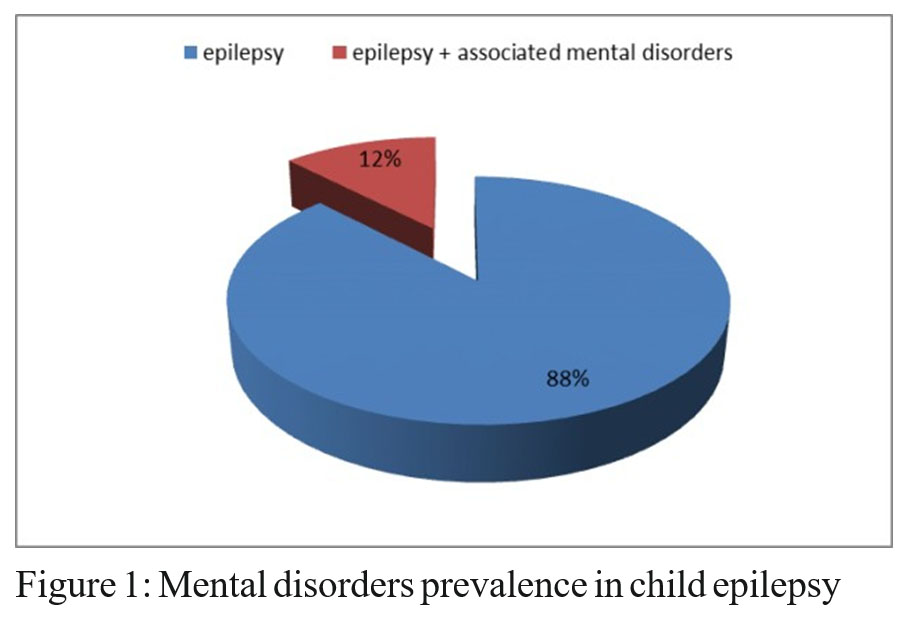
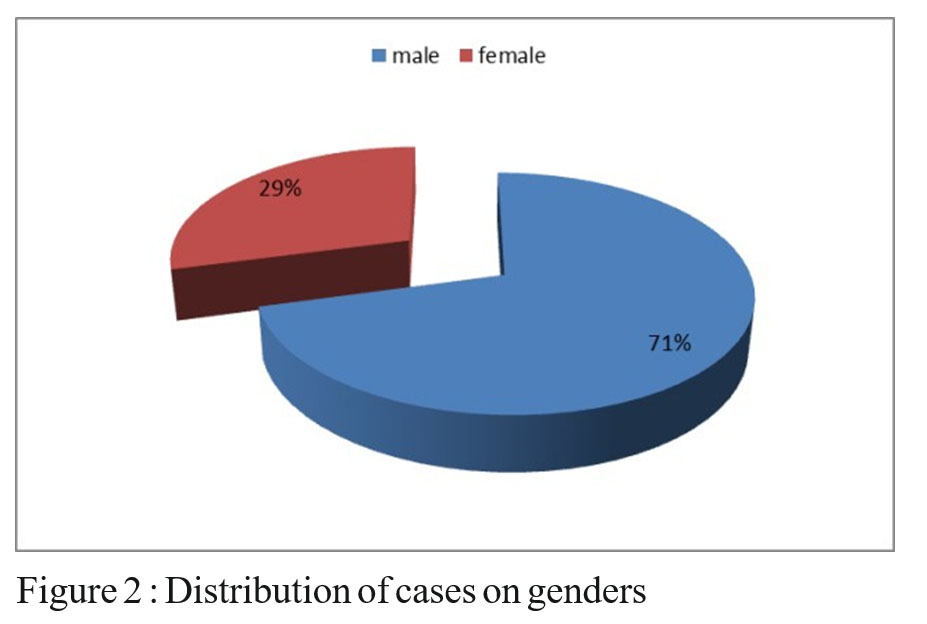
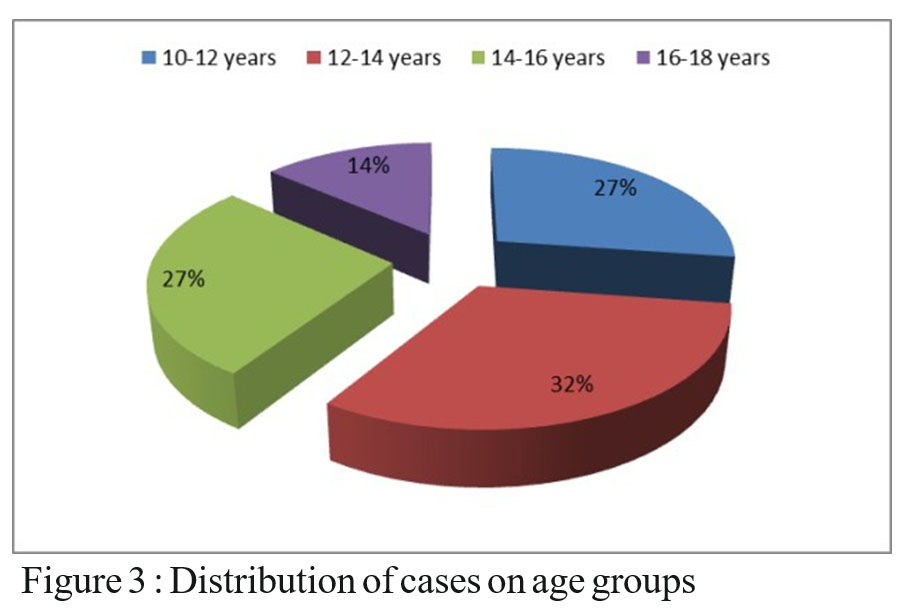
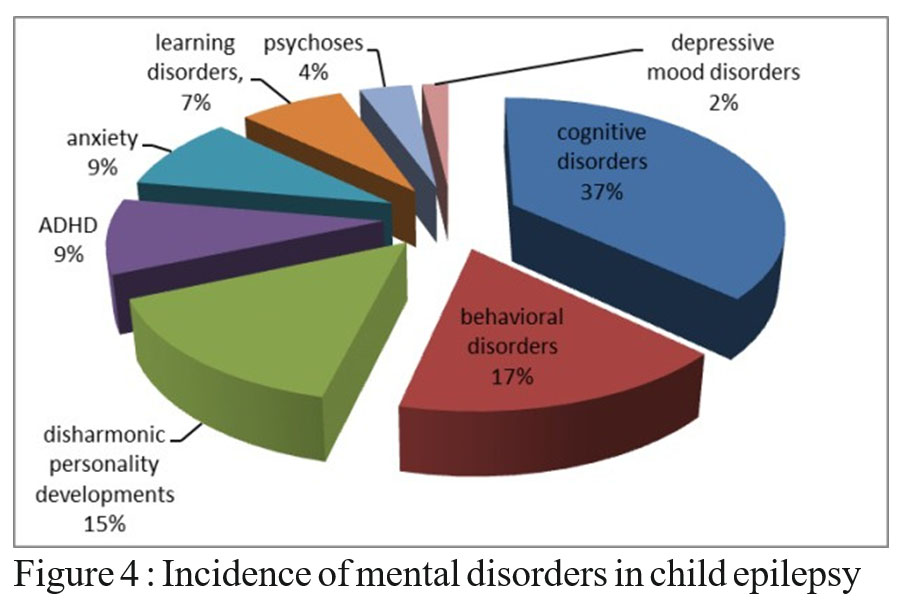
The incidence of mental disorders in epileptic children according to their background has been equal between the urban and rural environment, namely 50%.
The mental disorders encountered in the child diagnosed and treated for epilepsy have been:
– cognitive disorders: (37%);
– behaviour disorders: (17%)
– disharmonic personality developments: (15%)
– attention deficit hyperactivity disorder: ( 9%)
– anxiety: ( 9%)
– learning disorders: (7%)
– psychosis: (4%)
– mood disorders of depressive nature: (2%)
Behaviour disorders have been encountered in 11 patients consisting in irascibility (2 cases), disobedience and stubbornness (4 cases), auto- and hetero-aggressive manifestations (5 cases).
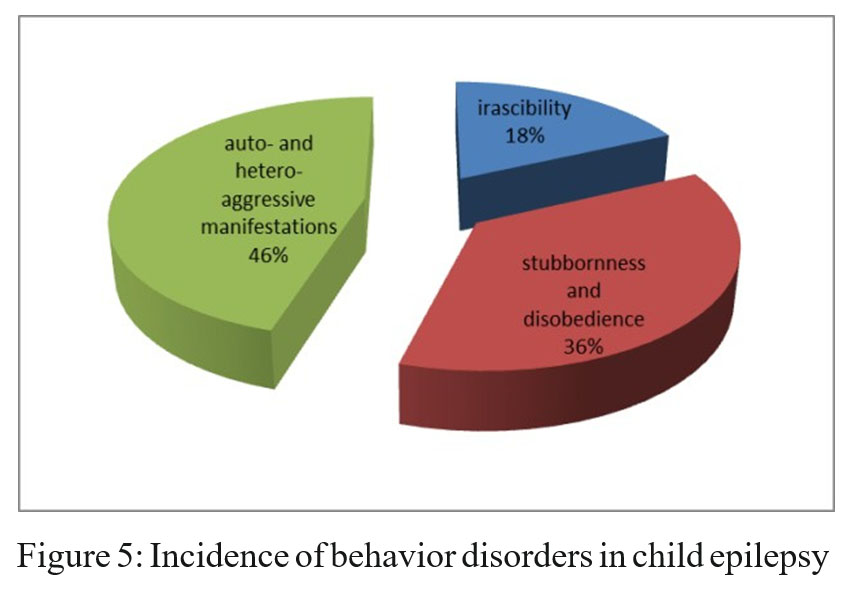
Personality disorders have been encountered in 8 cases, consisting in withdrawal (1 case), viscosity (1 case), impulsiveness (4 cases), antisocial manifestations as theft and consumption of alcohol (2 cases).
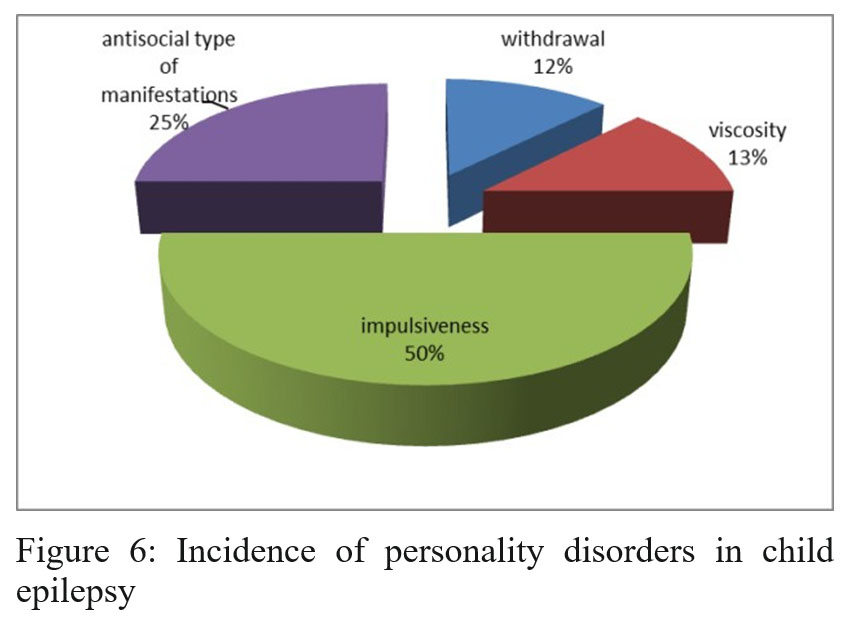
The psychotic type of disorder has been the most severe mental disorder in the epileptic child, consisting in mystical and paranoid delirious ideas, in 2 cases (8%). Language disorders were also present consisting in dyslalia, stuttering, dysarthria in 13 children. Also there have been encountered affective and mood disorders namely: 1 case of depressive disorder, and also 1 case of anxiety.
The associated cognitive impairment in the children patients with epilepsy under treatment, has consisted in mild mental retardation (intellectual disability) with schooling in aided school in 25% of cases, moderate mental retardation in 17% of cases and severe mental retardation in 37% of cases, and 21 % of the patients had a normal cognitive level.
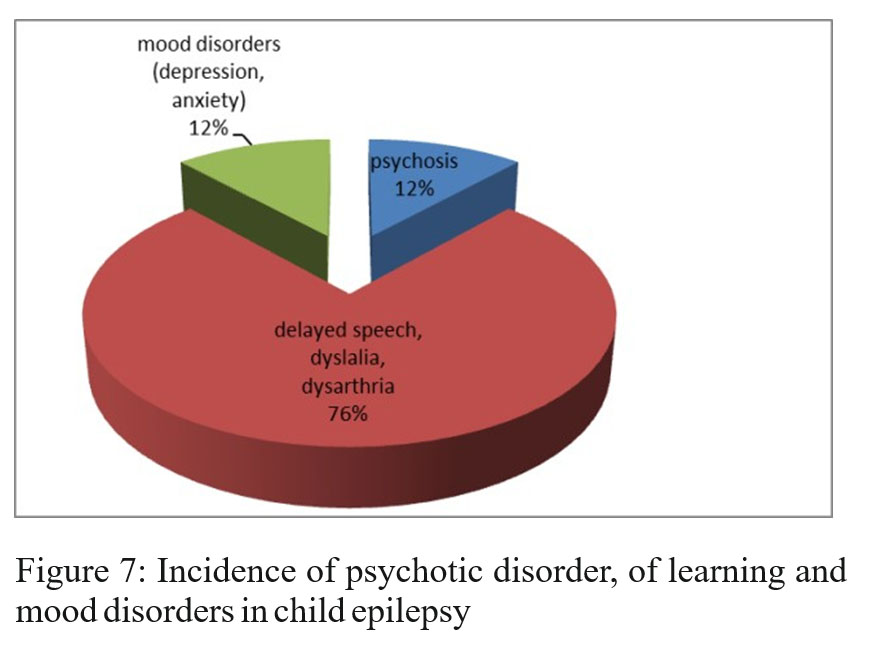
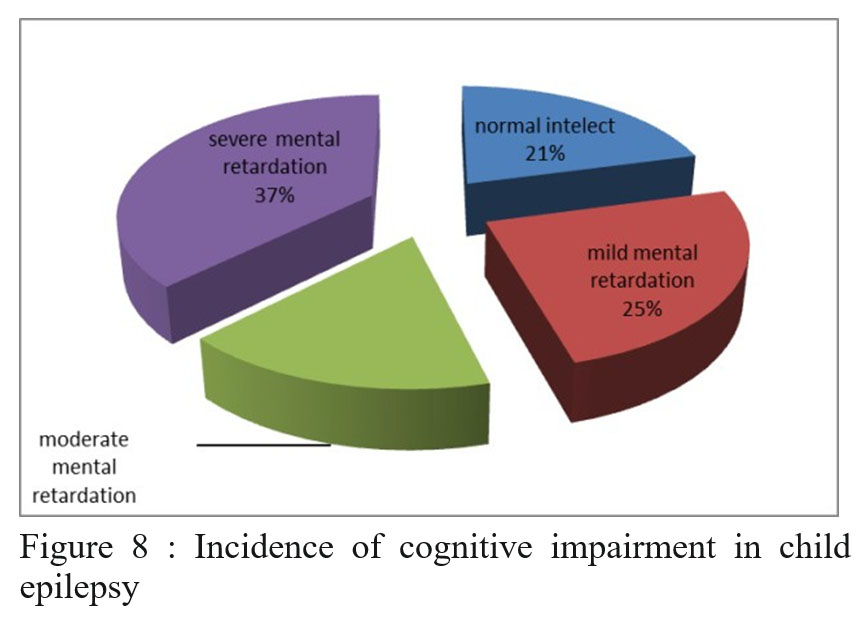
The severity of the cognitive impairment has been correlated with the age at the epilepsy onset, thus in 45.8% of cases the onset of the epileptic seizures has occurred before the age of 3. 17% of the epileptic children have not been schooled, due to the seizures frequency and lack of favourable response to the antiepileptic treatment, at the same time due to the associated cognitive impairment.
Discussions
Recent studies point out the fact that child epilepsy evolves with a high risk for the occurrence of cognitive impairment, behaviour disorders, emotional disorders, language or mood disorders. This risk is all the more higher as the structural underlying disorders to the epileptic process are more pregnant(2). The monitored patients presented a cognitive impairment in most of the cases (79%), only 21 % of them having a normal cognitive level. At the same time the behavioural disorder consisting in disobedience, irascibility, impulsiveness with auto- and hetero-aggressiveness has been present in 11 patients.(12) In most of the epileptic children within the study (45.8%) the onset of the epileptic seizures occurred before the age of 3, when the child’s psychic is at its peak of development, therefore the psychic vulnerability is higher, aspect mentioned also in the specialized literature (1,2,6) Personality disorders appear in a 1/3 of the epileptic patients , fact emphasized also in the children within the study, namely in 33% of them, under the form of viscosity, adhesiveness, antisocial type of elements, instability, impulsiveness, consistent with the specialized literature data.(9,12)
It is mentioned the occurrence of psychosis in patients with temporal lobe seizures (5).
Epileptic children with psychotic decompensation within our study (2 cases) have presented seizures of complex absence type, complex focal seizures secondarily generalized, the structural lesion being in the temporal lobe.(5,7)
Some of the antiepileptic medications may cause reactions of behavioral or cognitive type (12). Within the study performed it could not be established if cognitive or behavioral disorders had a bearing on the antiepileptic medication treatment.(6)
Conclusions
Among the mental disorders in epileptic children, the most frequently emphasized was the cognitive impairment (79%).
The maximum incidence of mental disorders was in the age group between 10 and 12.
The early onset of epileptic seizures under the age of 3 constitutes an unfavourable prognostic factor for the occurrence of mental disorders as language disorders, cognitive impairment, behavioral disorders.
The prognostic of mental disorders in child epilepsy is influenced by brain structural anomalies responsible for the epileptic seizures, also the therapeutic response at specialized medication.
Bibliography
1. Popescu V, Arion C., Dragomir D.: Convulsions and epilepsy in child, Medicala Publishing, Bucharest, 1989, 298-301.
2. Benga I: Epilepsy and non-epileptic seizures, Medical University Publishing „Iuliu Hatieganu”, Cluj-Napoca, 2003, 271-275.
3. Kaplan HI:Synopsis of Psychiatry, Seventh Edition, Williams and Wilkins, Baltimore, 1994.
4. M J Jackson1,D Turkington2: Depression and anxiety in epilepsy, N e u r o l N e u r o s u r g P s y c h i a t r y 2 0 0 5 ; 7 6 : i 4 5 – i 4 7 doi:10.1136/jnnp.2004.060467
5. Trimble MR, Schmitz B: Schizophrenia and other psychoses, in Aicardi J: Epilepsy: a comprehensive text book, 2007, 204:2113-21
6. Rogozea R, Magureanu S, Constantin D: Updates in epilepsy, Tehnica Publishing, Bucharest, 1998, 108-110
7. Sander JW: Epilepsy, Questions and answers, 2000
8. Popescu V: Pediatric neurology, Teora Publishing, 2001, 619-622, 627-634, 893-900
9. Dome L: Szemelyiseg zavarok, Filum Publishing, 2001
10. David A.S, Fleminger S,: Lishman’s Organic Psychiatry, Wiley- Blackwell, 2009, 333-354
11. Barnhill I, Hurley A: Mood disorders and epilepsy, Ment. Health Aspects Dev. Disabil., 2003, 6:36-39.
12. Leung LS, Mc Lachan RS: Behaviours induced or disrupted by complex partial seizures, Neurosciences and behaviour reviews, 2000, 24:762-775.
***




